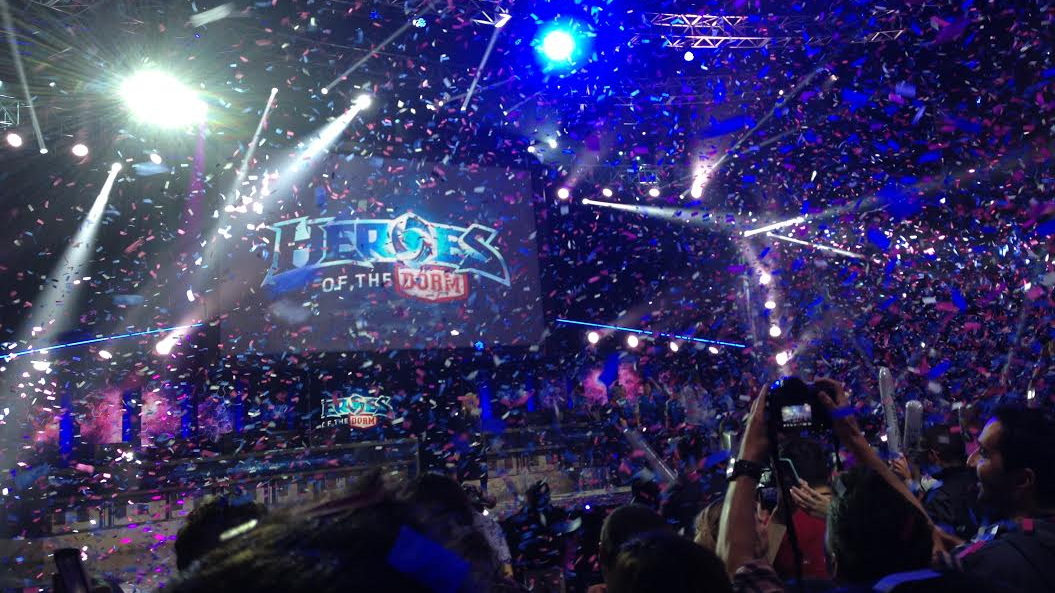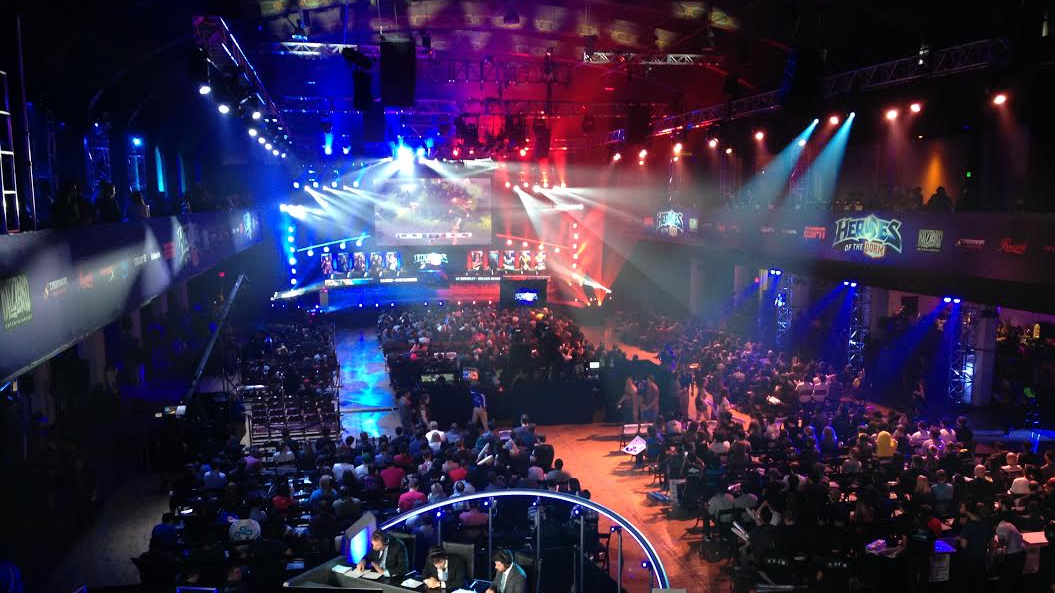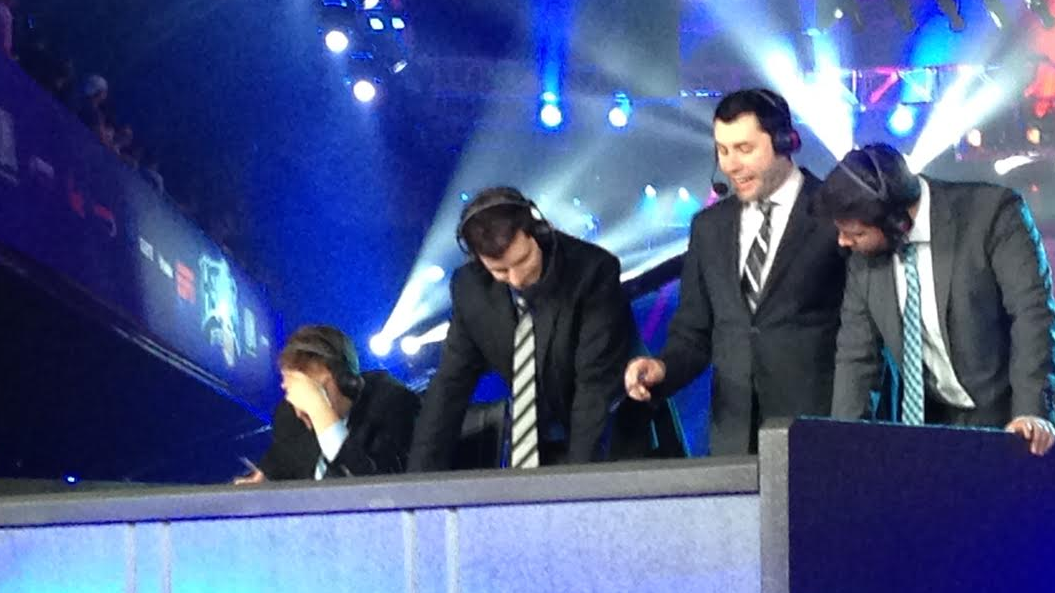
The scale of the Heroes of the Dorm grand finals shocked me. When I entered the Shrine Auditorium in Los Angeles this weekend, I wasn’t sure what to expect. On one hand, Blizzard was running a collegiate tournament, which historically garner less excitement than major esports events, and it was for Heroes of the Storm, a free-to-play game that hasn’t even left closed beta yet. On the other, the final match was set to be shown live on ESPN 2, the first time an esport has ever been broadcast on a major American television network, and the first place prize was massive—free tuition for the rest of the winning team's college career. Unsure of how high to set expectations, I found myself blown away by the production values, but more skeptical about ESPN’s involvement, though I appreciate the attempt to broaden the esports audience.
Heroes of the Dorm was on par in scale with most other esports events I’ve been to, including the League of Legends' Season 2 World Championships, and the auditorium was completely packed. What took Riot Games two years and the creation of the LCS to build up to, Blizzard put together for a weekend tournament for an unreleased game. At its core, the event was a marketing campaign to drum up interest for Heroes of the Storm before its full launch on June 2nd, but I think the implications are much larger.
Regardless of what you think of Heroes of the Storm—and many current MOBA players have already billed it 'the one for casuals'—ESPN broadcasting it live, right next to the NBA playoffs, is an important moment for esports. ESPN tested the waters late last year by showing Dota 2’s The International on ESPN 3, its live streaming service, but giving an esport actual broadcast air time is a big step. To a certain degree, Heroes of the Storm’s more casual nature actually worked in its favor, given the need to appeal to an audience not necessarily familiar with the genre's conventions. Or, more likely, competitive gaming entirely.

At the event I spoke to one of the game’s Technical Designers, John Hodgson, who felt the choice to make it a collegiate event was also beneficial. “It certainly helps to have something recognizable. If you’re going to put something on TV and say ‘this is Team Liquid versus Cloud Nine, people don’t really know who those people are, but people know who Berkeley is. That’s a college. People know who ASU is.” And it isn’t something that only works for those unfamiliar with esports; I found myself rooting for one school over another based solely on my own alma mater. If nothing else, the Heroes of the Dorm tournament made me hungry for more high quality collegiate esports.
Unfortunately, in all the excitement over the genuine progress esports made yesterday, the average gamer might have been left in the lurch. A common complaint over the course of the entire tournament was the reduced spectator UI used for every match. “Honestly it was a requirement of the ESPN folks,” Hodgson told me. “They need the UI to fit within a certain screen space.” But regardless of the UI size, key features like experience bars, respawn timers, and—perhaps most egregiously—the minimap weren’t displayed during matches.
That, coupled with the shoutcasters’ frequent restating of the rules, made the game less intimidating for those unaccustomed to watching video games, but hid vital information from gamers interested in higher level strategy. “We’ve learned so much from [this tournament]. We’ve learned what’s necessary to show, and what’s not,” said Hodgson. “We’ve gotten a lot of feedback about the minimap, for example. We kind of took it for granted when it was in the corner and you’re playing with it, right? But without it, you needed that excitement to see the players moving around, to see there’s always stuff going on. So we’re going to continue to work on that.”

Blizzard clearly understands that sacrifices needed to be made in order to ensure Heroes of the Dorm appealed to the ESPN crowd, but I don’t like the idea of leaving behind the hardcore to make that happen. When the finals went live on ESPN 2, they shut off the online stream. That meant fans of the game who didn’t have access to ESPN missed seeing the finals live. If you lived outside of the United States, you had even less of a chance of catching it, and VODs of the finals have yet to be posted online. [Update: VOD's are now uploaded to the Heroes of the Storm Youtube channel.] ESPN seemed to be happy with how the broadcast performed with its audience, so this could potentially be a necessary sacrifice in bringing esports to a wider demographic of viewers, but is it really worth completely abandoning the core group of people who have supported and engaged with Heroes of the Storm to appeal to a group who has no idea what it is?
The biggest gaming news, reviews and hardware deals
Keep up to date with the most important stories and the best deals, as picked by the PC Gamer team.
That said, I was hugely impressed with how engaging Heroes of the Storm was in a high stakes live event. All the griping about it being too casual seemed to melt away when there were so many exciting moments happening so quickly, and the roar of the crowd was as enthusiastic as any other esport. I’m unsure if any MOBA will be able to go toe-to-toe with League of Legends or Dota 2 in the immediate future, but Heroes of the Storm took an important first step for esports that will help open more doors for all three games. As long as we don’t lose too much in translation, I’m happy to welcome the newfound ESPN audience, and to see what television coverage can do to strengthen the popularity of all competitive gaming.


